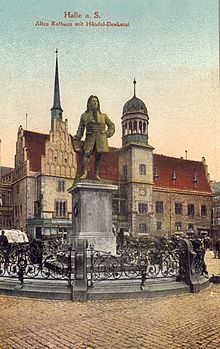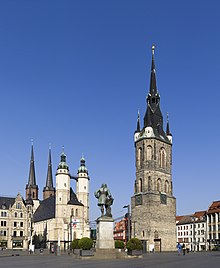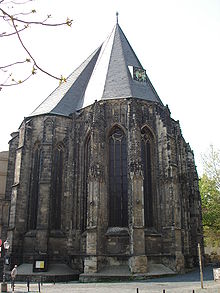Halle (Saale)
Template:Infobox Municipality in Germany/Maintenance/Type unknown
Halle (Saale), from about the end of the 15th to the end of the 17th century Hall in Saxony, until the beginning of the 20th century also officially Halle an der Saale, from 1965 to 1995 Halle/Saale, is a large city in the south of Saxony-Anhalt in Germany and with 237,557 inhabitants (Statistisches Landesamt as of 30. June 2020), it is the fourth-largest city in the former East Germany, the largest city in Saxony-Anhalt, and was ranked 31st on the list of large cities in Germany in 2019. Halle is home to the headquarters of the National Academy of Sciences Leopoldina and the Federal Cultural Foundation, which have the duties of official international representation of national science as well as German culture for the Federal Republic of Germany.
Together with the neighbouring metropolis of Leipzig, the city forms the Leipzig-Halle conurbation, which is home to more than one million people, and together with Leipzig and five other cities in Saxony-Anhalt, Saxony and Thuringia, the metropolitan region of Central Germany. Halle is one of the three major centres of the state of Saxony-Anhalt, is an important transport hub as well as a major science and business centre in the eastern German states. The city is located in the so-called chemical triangle between Schkopau and Bitterfeld-Wolfen.
The first documented mention dates back to the year 806. With the Francke Foundations founded by August Hermann Francke in 1698, Halle is considered the starting point of social-humanist education in Germany. Halle is the only major German city that had more than 200,000 inhabitants during the Second World War and was not extensively destroyed, so that its overall condition in terms of urban planning and monument preservation is considered unique among major cities.
Halle is home to one of Germany's oldest universities, the Martin Luther University Halle-Wittenberg, as well as the Halle Protestant College of Church Music and the Burg Giebichenstein University of Art Halle. There are a number of important cultural and museum institutions in the city area, such as the Moritzburg art museum in Halle (Saale), the Händel birthplace and the State Museum of Prehistory with the Nebra Sky Disk, which is a UNESCO World Documentary Heritage site.

Old Halle town hall (demolished as a ruin in 1948), with Handel monument, view around 1905. An initiative is striving to rebuild the town hall.
_Logo.svg.png)
Logo of the city of Halle (Saale)

Market Square with Market Church, Händel Monument, Red Tower and Roland in front of it. The Market Church and the Red Tower together form the landmark of the "Five Towers".
_p548_Marktplatz_zu_Halle_a.d._Saale_(anno_1500).jpg)
Market place in 1500, with the Gertraudenkirche and the Marienkirche before their demolition - lithograph from Hertzberg: Geschichte der Stadt Halle an der Saale von den Anfängen bis zur Neuzeit, Volume 1, 1889
Geography, hydrography and geology
Halle lies on the north-western edge of the Leipzig lowland bay, the larger part east of the navigable Saale, which here divides into several arms and forms a wide floodplain, and below the mouth of the White Elster.
The Saale flows through Halle over a length of 27 km. The Stromsaale manages a difference in altitude of 9 m. To make it navigable, five weirs with locks were built. Together with the tributaries, spillways, locks and lock canals as well as harbour basins, this results in a total length of 47 km of watercourses in the city. In addition, the Weiße Elster, the Reide and other tributary streams have a flow length of 6.3 km. In addition, there are about 180 man-made standing waters in the city area. The Hufeisensee is with 73 ha the largest lake of the city. Other larger lakes are the Osendorfer See with 21 ha and the Heidesee with 12.5 ha.
See also: List of water bodies in Halle (Saale)
The highest elevation is the Große Galgenberg with 134.2 m above sea level. The lowest point is 71 m above sea level on the bank of the Forstwerder, an island in the Saale near Trotha. At the Händel monument on the market square the height is 87 m above sea level.
Mineral resources and their use
The mineral resources in the city area contributed to Halle's favourable location. In many cases, their use has had a positive influence on economic development. Lignite deposits exist under many parts of the city. They have been used for economic purposes for several centuries, both in open-cast and underground mining, especially in the west of the city around the village of Nietleben, in the north (Seeben and Frohe Zukunft) and in the south-east (between Osendorf and Büschdorf). Hard coal could be mined in the former royal coal mine Dölau and in the area of the Wittekind valley. Clay was extracted at Angersdorf, shell limestone at Neustadt, porphyry at Galgenberg, gravel in the Saale floodplain and kaolin clay northwest of the city limits at Salzmünde. The use of brine, which could be extracted in some places in the city area as a result of the Halle marketplace fault, was of outstanding importance. Today, the extraction of mineral resources from the city's territory no longer plays a role. Today, many opencast mines form bodies of water.
See also: List of water bodies in Halle (Saale)
Neighboring communities
The following cities and municipalities, named clockwise starting in the north, border the city of Halle (Saale). They all belong to the Saalekreis, which surrounds the city in a ring:
The unified municipality of Petersberg, the town of Landsberg, the unified municipality of Kabelsketal, the municipality of Schkopau and Teutschenthal and the unified municipality of Salzatal as well as the town of Wettin-Löbejün.
City breakdown
→ Main article: Boroughs and districts of Halle (Saale)
The city area is divided into five boroughs: Central, North, East, South and West. The boroughs are subdivided into districts and these in turn into neighbourhoods.
Climate
In the normal period 1961-1990 of the weather station Halle-Kröllwitz the average air temperature was 9.1 °C and the annual precipitation 451 millimetres. Halle is located in the Central German arid region and is one of the driest cities in Germany.
| Monthly average temperatures and precipitation for Halle (Saale)
Source: DWD, data: 2015-2020 | ||||||||||||||||||||||||||||||||||||||||||||||||||||||||||||||||||||||||||||||||||||||||||||||||||||||||||||||||||||||||||||||||||||||||||||||||||||||||||||||||||||||||||||||||||||||||||||||||
-Deutschland.png)
Climate diagram of Halle-Kröllwitz

View to the Saale near Kröllwitz, with the restaurant Krug zum grünen Kranze, known from a folk song

Historical greeting card from Halle seen from the Burg Giebichenstein
Religions
Confession statistics
Currently (as of December 31, 2018), of the 241,333 residents, 21,505 (8.9%) are Protestant, 9,642 (4.0%) are Roman Catholic, and 210,186 (87.1%) are non-denominational or belong to another religious community.
The vast majority of the city's population is non-denominational. Since the 1970s, the number of non-denominational residents has increased about tenfold.
Protestant churches
From the beginning, the city of Halle belonged to the archdiocese of Magdeburg in the diocese of Merseburg. From 1194 onwards there were archpriests' seats in Halle, but it was probably not until the 12th century that the city had its planned integration into the ecclesiastical structure of the diocese. From 1518 onwards, the Reformation gradually took hold of the city's citizens. This process was completed in 1541, and Halle was henceforth a Protestant city for several centuries. The Lutheran confession was predominant, but a Reformed congregation was also founded in the 17th century.
In 1698 August Hermann Francke founded the Francke Foundations in Halle, named after him, a social institution that still exists today. Twelve years later, in 1710, Francke, together with the jurist Carl Hildebrand Freiherr von Canstein (1667-1719), co-founded the Cansteinsche Bibelanstalt (Canstein Bible Institute), which is still based in Halle today and is dedicated to the printing and distribution of Bibles.
As a result of the Peace of Westphalia, Halle fell to Brandenburg in 1680. The city belonged to the Duchy of Magdeburg and shared the ecclesiastical fate with the whole Duchy, i.e. in 1817 Lutheran and Reformed congregations were united in the whole of Prussia to form a single regional church (Uniate Church). All of Halle's Protestant parishes then belonged to the Evangelical Church in Prussia or its provincial church in Saxony, whose head was the respective King of Prussia as summus episcopus.
The Evangelical Lutheran (Old Lutheran) Church in Prussia came into being as a reaction to the union between the Lutheran Church and the Reformed tradition, which was imposed by force by the Prussian state. In Halle, therefore, the Evangelical Lutheran congregation of St. Mary Magdalene was founded, which today belongs to the Saxony-Thuringia church district of the Independent Evangelical Lutheran Church. It celebrates its Lutheran masses in the St.-Maria-Magdalena-Chapel on the Moritzburg.
After the abolition of the sovereign church regiment in 1918, the Provincial Church of Saxony was a founding member of the "Evangelical Church of the Old Prussian Union" and was an independent regional church (Evangelical Church of the Church Province of Saxony) with a bishop at its head from 1947 to 2008. The Protestant parishes of Halle belong - unless they are free churches - to the Halle-Saalkreis church district within the Halle-Naumburg provostry of the Protestant Church in Central Germany, whose seat is in Halle.
In addition to the congregations and institutions of the regional church, there are a large number of other Protestant churches, the majority of which are counted among the free churches. These include, among others, a Baptist congregation (services in the Friedenskirche).
Roman Catholic Church
In the 19th century the number of Catholics in Halle increased again. From 1821 they belonged to the diocese and from 1929 to the archdiocese of Paderborn. After the Second World War it became increasingly difficult for the archbishop to carry out his official duties in the eastern part of his archdiocese. Therefore, in 1946 a Vicar General was appointed in Magdeburg, who was appointed Auxiliary Bishop in 1949, and to whose district the parishes in Halle also belonged. Due to the reorganization of the Catholic Church in the GDR, the areas were formally separated in 1972 and elevated to the Episcopal Office of Magdeburg. The head of this office became an Apostolic Administrator with the title Bishop. On 8 July 1994 the former Episcopal Office of Magdeburg was elevated to a diocese and (again) placed under the Archdiocese of Paderborn as a suffragan bishopric. The parishes of Halle thus belong today to the deanery of Halle within the diocese of Magdeburg.
More
There is also a small Old Catholic parish in Halle, which holds its services once a month in the St. George's Chapel in the Francke Foundations.
There are two Jewish communities in Halle: The Jewish Community of Halle belongs to the State Association of Jewish Communities in Saxony-Anhalt, the Synagogue Community of Halle is independent.
Furthermore, there is a small Russian Orthodox congregation which holds its services in the house church of the Holy Cross in the Francke Foundations, as well as a congregation of the Armenian Apostolic Church.
Bahaism, the New Apostolic Church, the Seventh-day Adventists and Jehovah's Witnesses are also represented in Halle.

The Halle Cathedral

Moritzkirche, three-nave late Gothic hall church, built 1388-1511
Search within the encyclopedia